This article is part of our body language guide. Click here for more.
Did you know that head movement is highly correlated1https://journals.sagepub.com/doi/10.1177/002383098302600202 with how we speak? We can’t help but nod, twist, and turn our heads, depending on what we say. And not only that:
Since the head houses our brain, we instinctively move our heads depending on how we feel.
So what exactly is the head saying? And what are the 26 different head gestures to know?
Here’s what you’ll learn in this article:
- how one horse shocked the world and drew in crowds… using body language
- the head cue that can boost your attraction (in less than one second!)
- the #1 head cue you can use to persuade someone to agree with you
- how to tell if someone is aroused by looking at their forehead
- why Botox face makes us feel creeped out

Can You Read Body Language?
How good are your body language skills? Take our free body language quiz to find out!
How a Horse Was Able to Tell Time

It was the year 1900 in old Berlin when a man named Herr von Osten purchased a horse. And this wasn’t just an ordinary horse—this horse became one of the most famous horses in history for his ability to count.
Named “Clever Hans,” the horse attracted crowds from afar by showing off his ability to count by tapping his hoof. Clever Hans was so smart that he could tell time, recall musical pitch, and even count the number of people wearing eyeglasses in the crowd.
How was this possible? Was this just an extremely gifted horse, or was there suspicious activity going on behind the scenes? A formal investigation was conducted to find out.
The experimenters, figuring that it was von Osten that was secretly telling the horse the correct answer, removed von Osten from the scene and submitted the horse for questioning. Upon examination, Clever Hans was still able to count correctly! It seemed that Clever Hans was one especially talented horse.
But skepticism continued, and it wasn’t until a second experiment was performed that the truth was finally revealed. In this experiment, von Osten whispered a number into the horse’s left ear, and another experimenter whispered a different number into the horse’s right ear. The horse was then asked to add the 2 numbers together.
Watch our video below to learn how to read people and decode 7 body language cues:
And for the first time, Clever Hans failed. It turns out, the key to Hans’s cleverness was his ability to read gestures.
Whenever the crowd gave an “expectant gesture” toward an answer—such as by bending the head slightly forward—Clever Hans picked up on that and knew when to stop tapping his hoof. Surprisingly, he could even detect small head movements as slight as ⅓ millimeter!
Since neither von Osten nor the experimenters knew the answer in the second experiment, there was no expectant gesture, and therefore no cue to signal the correct answer.
Clever Hans was finally debunked—but this just goes to show the power of body language cues!
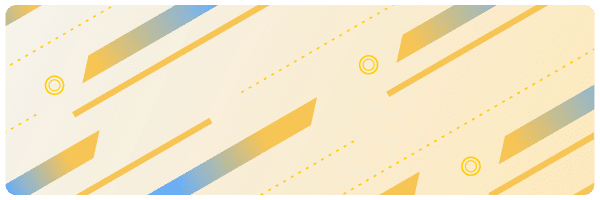
9 Positive Head Body Language Gestures
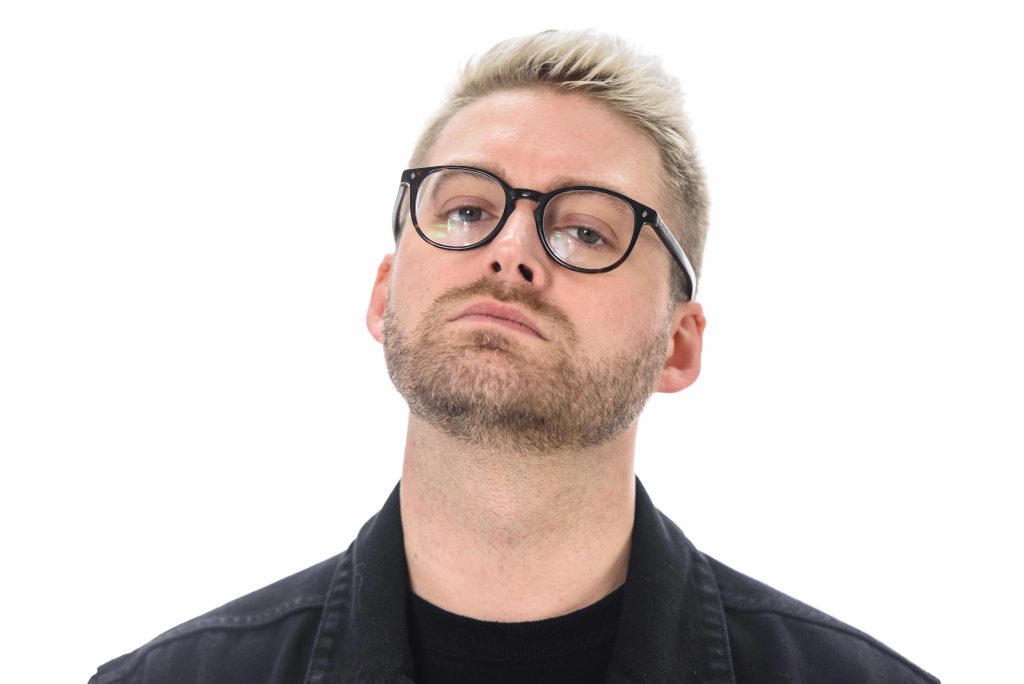
I’m prideful
Think about the most confident person you know. For me, it has to be my father. Imagine them—where do they hold their head? Is it held high or down low? Chances are, they have their head up.
What It Means: Confident people tend to have their head held up high. In high school, I would tend to look at the ground and avoid eye contact, a good indicator of low self-worth.
According to body language expert Dr. Lillian Glass2https://www.amazon.com/The-Body-Language-Advantage-Relationships/dp/1592335152?tag=bisafetynet2-20, to look confident, you have to always pretend that there’s a “string holding the crown of your head up.”s
The head nod is so universal that it can be recognized from industrialized Western cultures to even the most ancient African tribes3https://www.amazon.com/Nonverbal-Communication-Human-Interaction-Knapp/dp/1133311598.
Pro Tip: How to Be More Attractive in One Second
Are you a man? Here’s some good news: you can literally be 2.3x hotter right now. Research by Doctors Danielle Sulikowski and Darren Burke says that men’s faces are more attractive to women when they are tilted upwards3https://www.amazon.com/Nonverbal-Communication-Human-Interaction-Knapp/dp/1133311598.
Why? Because if you tilt your head back, there’s a small but perceptible height increase. This is similar to when taller men hover over shorter women. So yes, height DOES matter. But you don’t have to drink lots of milk to subtly increase your perceived height!
And if you’re a woman? The same researchers4https://onlinelibrary.wiley.com/doi/abs/10.1111/eth.12412 found a downward head tilt is seen more attractive. This indicates submissiveness.

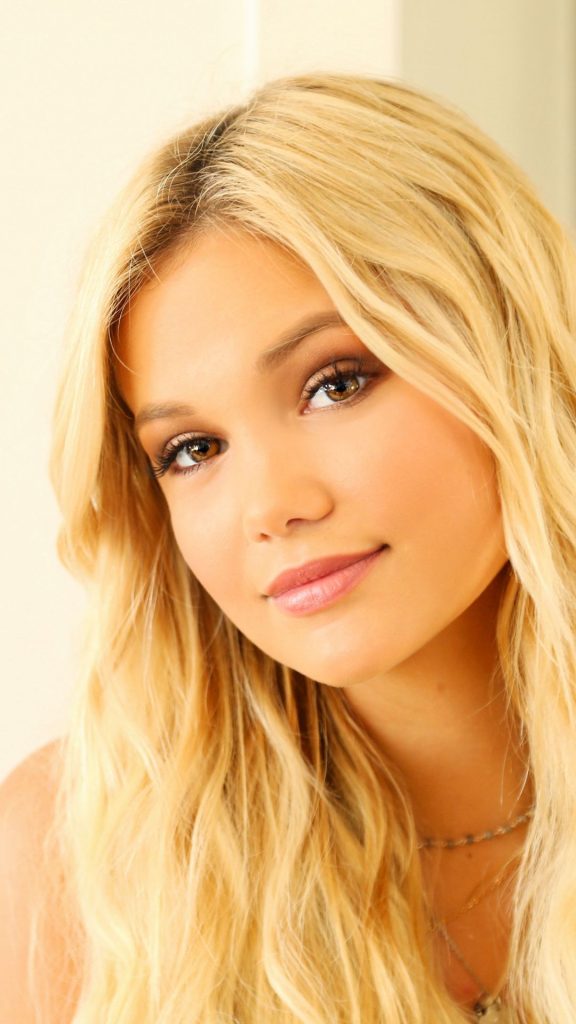
You may also be wondering…
Why do guys tilt their heads back?
A short, quick motion back is sometimes called the “guy nod.” Here’s a quick tip to remember head nod direction: Head nod down = respect and humbleness. Head nod up = informal and coolness.
How To Use It: An upward-tilted head can be used to display pride and confidence, and heads that tilt a lot could signal sympathy. Head tilting also instantly increases your charisma and signals interest.
For example, I recently made a video on Kamala Harris’s body language:
Her body language says it all: warmth and competence. She smiles with her eyes and exposes her neck to show that she is accepting of being vulnerable. Her shoulders are down and back. The space between her arm and torso says she feels confident.
She also has her hand on her heart. This signifies warmth and sincerity. And of course, Kamala is also tilting her head up and looking up. This ultimate nonverbal gesture of hope also makes us want to look up.
We feel more hopeful as we look up to those who are role models and people who care about us, like our parents. They seem to know everything. Tilt your head up to appear charismatic, confident, and tall.
I’m listening
What It Means: When a man nods, it’s an indicator that he agrees. But when a woman nods, it might mean she agrees OR is listening to, empathizing with, or encouraging the speaker to continue5https://www.amazon.com/Silent-Language-Leaders-Help-Hurt-How/dp/0470876360.
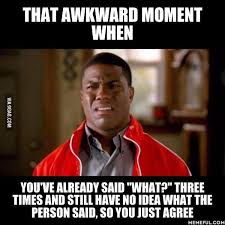
However, if you notice rapid head nodding in either gender, it can indicate the person wants you to hurry up and finish your talk so they can take their turn to speak.
And you’ll see this cue less in younger children: in a study6https://psycnet.apa.org/doiLanding?doi=10.1037%2F0012-1649.21.3.473 of 2-to-5-year-old children, older children were found to use more head nod cues when listening to adult speakers. This suggests that older children are more attentive and understand reciprocal speaking better than younger children do.
Even in remote tribes like the Australian Aborigines, a head nod is always a “yes” sign and never a “no.” This gesture is also recorded as used by Amazonian Indians, Inuit, Papuans, Balinese, and Samoans to agree, encourage, understand, or simply confirm a fact.
And how do you know if someone disagrees with you even though they nod their head? Look for pursed lips5https://www.amazon.com/Silent-Language-Leaders-Help-Hurt-How/dp/0470876360. This indicates disagreement and even resentment.
You can also spot a contradiction if someone nods their head but at the same time says no. For example, in the following clip, New York Yankees superstar Alex Rodriguez7https://nicolasfradet.com/hand-shrugging-a-very-revealing-poker-tell/ says “no” but nods “yes” when asked if he has ever taken any performance-enhancing substance.
Also, watch the microexpression on his mouth. The left side of his mouth comes up in contempt as he responds to the interviewer (timestamp 0:12):
Pro Tip: How to Get Someone to Agree With You
Finish your sentences with a verbal affirmation such as “isn’t it?” “wouldn’t you?” followed by a head nod. This increases listeners’ positive feelings and the likelihood of them agreeing with you8https://www.amazon.com/Definitive-Book-Body-Language-attitudes/dp/1409168506.
The triple nod
What It Means: The triple nod is the nonverbal equivalent of the ellipsis or three periods.
How to Use It: Triple nodding is a nonverbal cue for someone to keep talking. If you are introverted and aren’t great at making conversations, you want to encourage the person you are speaking with to keep talking.
Here’s how: Wait until they are done speaking and give a pause. Then, nod three times in quick succession, and they will often continue. If not, you can pick up where the conversation left off, but this is a great way of showing engagement and lengthening a discussion.
Why does it work? Research shows that people will actually talk 3–4 times faster than usual when listeners triple nod throughout conversations5https://www.amazon.com/Silent-Language-Leaders-Help-Hurt-How/dp/0470876360.
Pro Tip: Vary Your Triple Nod Speed
The speed of your head nod also plays a factor. It can signal patience or a lack of patience of the listener. A slow nod means, “I’m interested,” and a fast nod means “I’ve heard enough.” It’s a way to tell you to finish so they’d have their turn.
The head bow
What It Means: A slight bow of the head is more of a sign of respect, and it’s often used as a greeting. This is a submissive gesture and is used to make people in power feel authoritative.
If someone is wearing a hat, the hat may be held during a head bow to keep it from falling off:

How to Use It: In some cases, a head nod may be better than a handshake. For example, if you’re a salesman and observe closed body language from a potential customer, it may not be a good idea to lead with a handshake, as it’ll be unwanted. Instead, bow your head as a sign of respect, and wait to see if they initiate the shake.
Hooding
According to Joe Navarro9https://www.amazon.com/Dictionary-Body-Language-Field-Behavior-ebook/dp/B075JDX981, hooding is when fingers are interlaced behind the head, with the elbows flared out. This is a territorial display, and people who hood are comfortable and feel in charge. Hooding will rarely occur when someone of higher status is present.
By the way, why is it called hooding? It looks like how a cobra “hoods up” to alert other animals of its dominance and power.
How to Use It: Hood when you’re alone at the office or sitting on the sidelines at a house party and need a recharge. Hooding is a great confidence booster when you’re feeling low!
If you want a longer-lasting way to recharge your confidence, learning body language is extremely effective. With a good grasp of how people act (and think!), you’ll be able to effortlessly command your confidence in any social situation. Learn how!
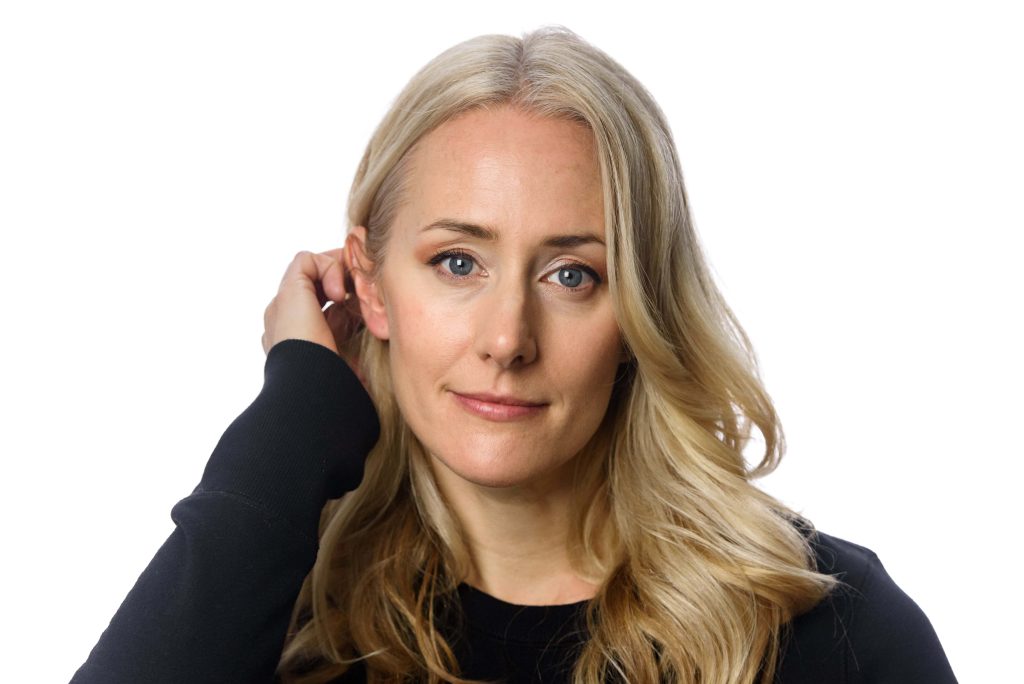
Look at me
What It Means: My daughter loves to play with her hair (and more recently, mine!). It’s a good indicator of someone being in a good mood when they feel relaxed. On the other hand, it could serve as a pacifier and a sign of stress.
During courtship, hair touching and preening increases. The amount of grooming between partners can also be a good barometer of their rapport and levels of intimacy5https://www.amazon.com/Silent-Language-Leaders-Help-Hurt-How/dp/0470876360.
Playing with the hair with the palm out indicates a public display of comfort, contentedness, and confidence. This is common in dating scenarios5https://www.amazon.com/Silent-Language-Leaders-Help-Hurt-How/dp/0470876360.
And if your date twirls or plays with her hair, and her wrist is exposed or facing outward, you may be onto a sign of her attraction or comfort since we don’t display our wrists when we are uncomfortable.
The “head toss and hair flick” gesture is also very common. It may even be the first display a woman uses on a date8https://www.amazon.com/Definitive-Book-Body-Language-attitudes/dp/1409168506. She may flick her head back and toss her hair over her shoulders or away from her face.
Pro Tip: How to Spot a Sad or Sick Person
When the brain is saddened or when we are ill, preening the hair and overall physical presentation are among the first things we ignore5https://www.amazon.com/Silent-Language-Leaders-Help-Hurt-How/dp/0470876360. This is because when a person is sick or traumatized, the brain has other priorities than preening. Take for example patients in hospitals—we may see them walk down the hallway with disheveled hair and in gowns with their backsides exposed.
How To Use It: Turn your torso toward the person you’re interested in, while flicking your hair with your palm out, to show interest. Never do this during a business presentation, unless you want to look aloof.
The head wobble
What It Means: This gesture is commonly associated with Indian culture. Take note that it could mean many things, based on the context of the conversation, but we generally understand it to mean “okay” or as a way to express understanding during a conversation.
And if you’re unfamiliar with it, the head wobble is more like a sway, rhythmically tilting the head from side to side, as if in an arc10https://www.amazon.com/Peoplewatching-Desmond-Morris-Guide-Language/dp/0099429780.
But it can get even more confusing: In Bulgaria, Greece, Turkey, Iran, Bengal, and the former Yugoslavia, what is a “yes” head nod to us is a “no” to them.
The Head Nod Mix-Up
When the Russian soldiers occupied Bulgaria in the last century, they had trouble understanding the locals because the Bulgarian “YES” nod looked so much like the Russian “NO.” So, Russians intentionally trained themselves to sway their heads when they meant yes to suppress their negative head shakes.
However, not only did it NOT work… it actually led to greater misunderstandings because the Bulgarians were never sure whether Russians remembered to switch to their head-nod system, or whether they had reverted momentarily to their own. Talk about confusing!
Aren’t I pretty?
What It Means: This gesture is used in courtship and by women and gay men to attract others8https://www.amazon.com/Definitive-Book-Body-Language-attitudes/dp/1409168506. You may even see exaggerated versions of this in TV shows:
How To Use It: Rest your chin on your hands to show interest in a romantic partner. Couple it with a smile, and add in raised eyebrows to maximize your attention gestures.
Head down looking up
AKA the Marilyn Monroe cluster. You can also couple this with a combination of gestures—lowering the eyelids, raising the eyebrows, and looking up with slightly parted lips to show sexual submissiveness8https://www.amazon.com/Definitive-Book-Body-Language-attitudes/dp/1409168506.
What It Means: You might see head lowering with eyes looking up in women if they desire to look appealing. Essentially, women do this to play the role of a young daughter to provoke protective feelings in men. You may even see the head cocking to the side. This mannerism stems from when we rest our heads against our parents’ bodies or during tender moments of love10https://www.amazon.com/Peoplewatching-Desmond-Morris-Guide-Language/dp/0099429780.
Pro Tip: How to Look Your Sexiest in Public
Tilt your head down and look up at your date. New research shows this is the expression many women have on their faces immediately before an orgasm. It makes women appear more babylike by making the eyes appear larger and the face smaller8https://www.amazon.com/Definitive-Book-Body-Language-attitudes/dp/1409168506.
Jennifer Lawrence uses this gesture to appear engaging and attractive and also points at her lips to make us want to pay attention to them:
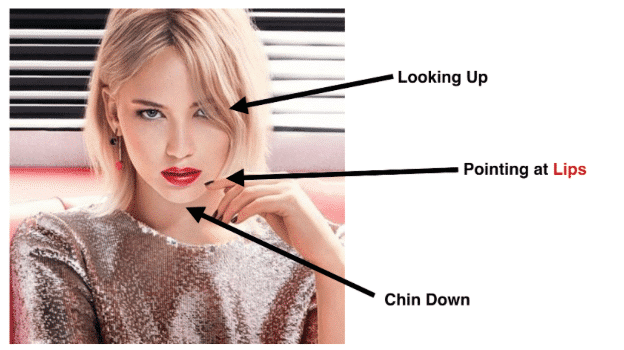

17 Negative Head Body Language Gestures
No
What It Means: When we want to say no, we shake our heads. Obvious, right? But it can also mean disbelief. Take a look at this example, when an audience reacts to Brad Pitt’s body in disbelief (timestamp 1:55):
And even more useful: you can use this cue to help spot a potential deception.
Pro Tip: How to Spot a Liar Who Shakes Their Head
Ask someone a question and watch for their head shake. If they say something positive such as “yes,” or “I love my wife,” while shaking their head no, it is usually a negative sign and can potentially mean the opposite of what they are saying.
The head shake is an inborn trait—the origin of this gesture can also be seen with infants refusing to be breastfed10https://www.amazon.com/Peoplewatching-Desmond-Morris-Guide-Language/dp/0099429780. Children who were genetically born blind, according to a 1973 study11https://www.researchgate.net/publication/228504501_Facial_expressions_in_various_emotional_states_in_congenitally_blind_and_sighted_subjects, even shake their head to either refuse objects or show disapproval when touched. That’s why you may see someone instinctively shake no even if they try to mask it.
Want to see this lie-spotting gesture in action? Take a look at this clip where Lance Armstrong says “100%, absolutely,” but shakes his head instead of nodding yes (timestamp 0:37):
Ruffle me up
What It Means: Morris says this is reminiscent of hair ruffles or strokes when we were a child. It signals the need for comfort. Also, women ruffle their hair 3x as much as men10https://www.amazon.com/Peoplewatching-Desmond-Morris-Guide-Language/dp/0099429780.
Check out this example of Kristen Stewart touching her hair:
When men run their fingers through their hair, it could indicate concern or doubt5https://www.amazon.com/Silent-Language-Leaders-Help-Hurt-How/dp/0470876360. They may want to ventilate and let air cool the vascular surface of their scalp. Also, this action stimulates the nerves of their skin as they press down.
And when women do it to pacify, they might quickly lift the hair at the back to cool down their neck. They may run their hands through their hair when concerned, upset, stressed, or flustered. If this is repeated, it signals that they feel overly stressed or overheated.
And have you ever seen hair flipping or touching, especially in hair commercials? This is done to draw attention12https://www.amazon.com/Dictionary-Body-Language-Field-Behavior/dp/0062846876. Our eyes are automatically drawn to the hands. Even with coma patients, it has been shown they try to track movement with their eyes. Check out the eye-catching hair commercial below (timestamp 0:04):
Rubbing back of head
What It Means: If you see someone rub the back of their head with one hand, it could mean that they feel confused or embarrassed. It’s similar to running hands through your hair. People generally do this to self-soothe.
Scratching head
What It Means: Chances are, you’ve scratched your head recently. It definitely could mean you’re just itchy, but in other cases, it could signal confusion, frustration, or stress.
Teachers often see students scratch their head as they ponder a test question12https://www.amazon.com/Dictionary-Body-Language-Field-Behavior/dp/0062846876. On the other hand, rapid scratching can indicate high stress or concern, and they may even be conflicted about what to do next.
How To Use It: If you see head scratching, offer a solution if you know a quick fix. Otherwise, try to use open body language to open up. You can even add slow, sympathetic head nods to show them you’re giving them your full attention.
I am astonished
A sudden reach for the head with both hands makes up this gesture. The hands may be near the ears but not covering them, with elbows pointed toward the front.
What It Means: According to Navarro, this cue happens when people are trying to protect themselves from something they are in disbelief of. For example, someone who drives into a mailbox might suddenly reach for their head in astonishment, as if saying, “What the heck just happened!?”
I reached for my head last week when I went out for my daily walk and forgot to turn off the stove!
Rubbing forehead or temples
What It Means: You might see someone rub their forehead or their temple when they are thinking or in deep thought.
Gerard Nierenberg from the Negotiation Institute in New York says that those who rub their foreheads when something bad happens tend to be more easygoing and open8https://www.amazon.com/Definitive-Book-Body-Language-attitudes/dp/1409168506.
However, rubbing one’s forehead brings up ideas of anxiety and doubt, so this is not a good gesture to use during a negotiation.
Pro Tip: How to Spot When Someone is Aroused
Look for the superficial temporal veins, or those nearest the skin on the sides of our heads, just behind our eyes. These veins might be rubbed, pulse, or throb visibly. This is usually an accurate indicator of arousal due to anxiety, concern, fear, anger, excitement12https://www.amazon.com/Dictionary-Body-Language-Field-Behavior/dp/0062846876.
Head down, no eye contact
What It Means: Hanging your head down might indicate shame or judging. You can see this from Trump’s speech (courtesy of Reddit). Notice how the 2 individuals standing behind Trump hang their heads down and make no eye contact at all:
We even see people walk with their heads down. This is a sign of low confidence, depression, or being defensive. It’s also quite apparent in some animals—for example, in those bull shows, a bull will often lower its head before charging toward the matador.
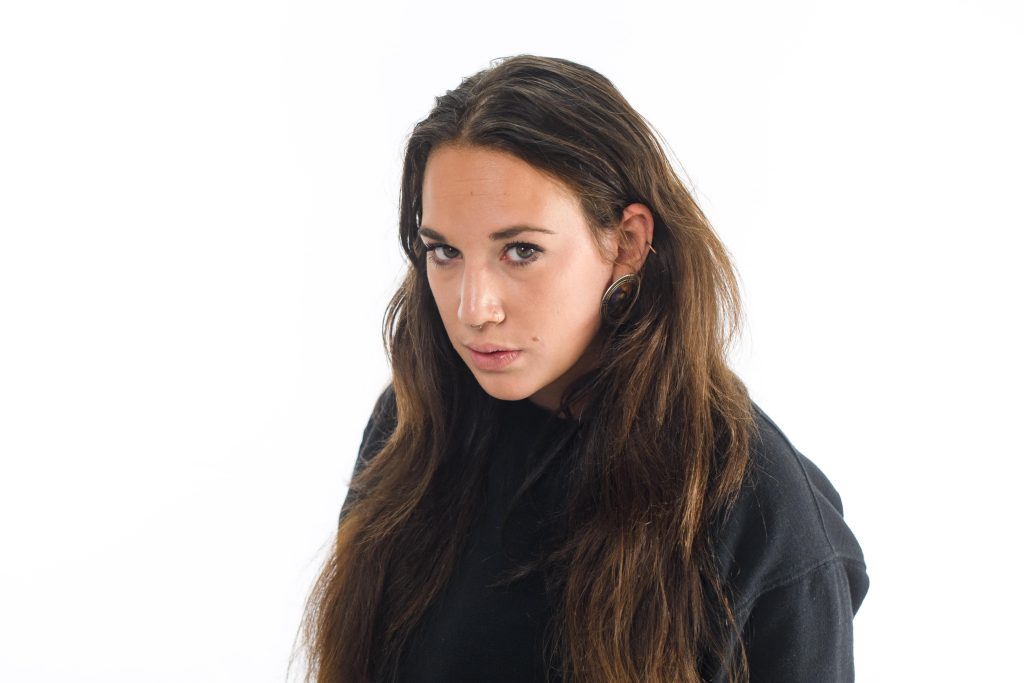
The head lower
This gesture is similar to the above, but a person’s head simply lowers and their eyes don’t drop to the ground.
What It Means: When a person lowers their head—especially after something unexpected happens—it may mean they feel ashamed.
Here’s an example of George Bush saying the “fool me once” saying, but he manages to botch it up and follows up with a classic head-lowering gesture (timestamp 0:46):
Sadly, losers might also lower their heads. We do not learn this expression by observation; we are innately programmed to do this when we lose. Losers roll their shoulders in, hang their head low, make a pained or sad expression, and clench their hands into fists of defeat.
It looks similar to a balloon deflating—as the air, adrenaline, and excitement leave the body, it wilts in sadness and frustration.
Turning head away
What It Means: If you see someone turning their head away, it might be a sign that they feel bored, disinterested, or uncomfortable during a conversation. I often see this from my daughter when I try to get her to eat her mashed peas.
You might also spot this during a negotiation—if it’s coming from the person you’re trying to persuade, and coupled with pursed lips, you might want to re-strategize.
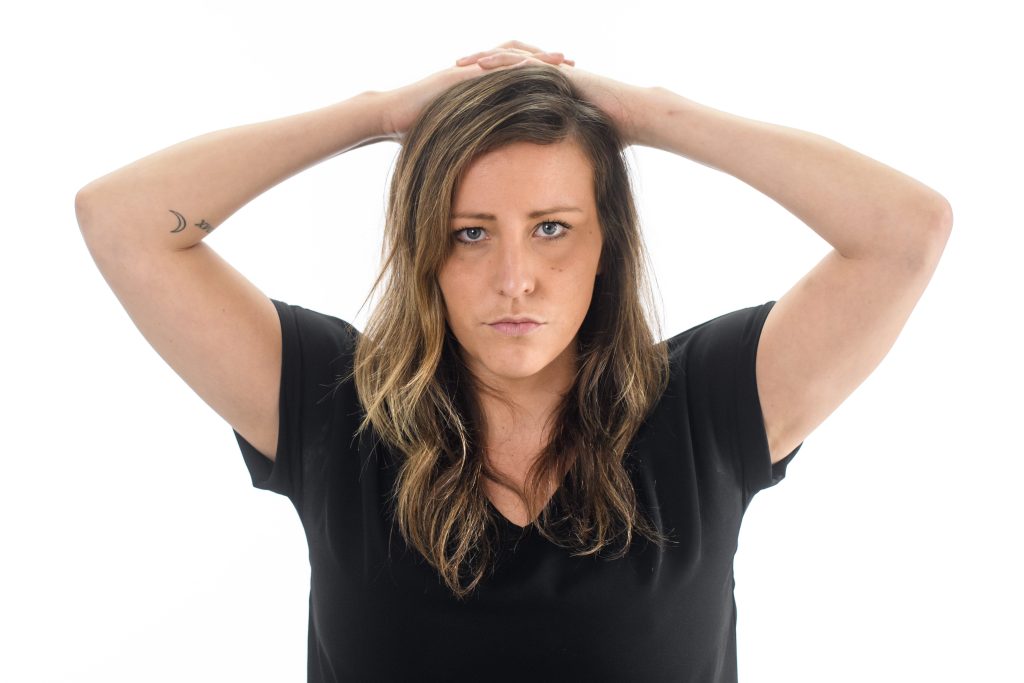
Hands on head
What It Means: You might have placed your fingers, interlaced, on top of your head, and your elbows flared out wide. This is a gesture that signals frustration and stress. And the worse the situation gets, the more your elbows might close together.
You might see a person’s hands on top of their head if they are struggling or overwhelmed with a task5https://www.amazon.com/Silent-Language-Leaders-Help-Hurt-How/dp/0470876360. Give me a Rubik’s cube, and you’d be seeing me do this gesture all day!
You might even see a person planting their hands on their head when a natural disaster hits, when things aren’t going their way, or when they’re generally struggling to do something. Taken further, this might even lead to hair-pulling cues!
What the whaaat!?
What It Means: If you see someone push their head back suddenly, it can indicate confusion, surprise, or even disbelief about something that was said or just happened. You may also see eyebrow movement or tight lips.
The double take
Wait, who goes there!? The double take is a classic cue that indicates you’re feeling surprised. You might see this cue from a friend you spot at a party, or even from a stranger if they’re attracted to you.
Otherwise, a person may be in disbelief at something you said.
Oh, no way! You bought Vanessa’s best-selling book, Captivate? Me too!
The slap
What It Means: This is easy! We do the forehead slap as a “duh” sign when we realize something or when we make an obvious mistake.
However, you likely won’t see this gesture if it was a serious mistake. The forehead slap shows that someone wouldn’t be necessarily intimidated by you pointing out their forgetfulness8https://www.amazon.com/Definitive-Book-Body-Language-attitudes/dp/1409168506.
Turtling
Turtling is characterized by the head lowering and shoulders going up. Typically, turtling involves pulling the head down, rolling the shoulders in, and trying to be as small as possible… just like a mini turtle!
What It Means: Turtling is similar to a “shocked” state when you hear a loud “bang” or someone shatters a plate on the floor. You can see this gesture when a boss walks by an employee who just wants to be ignored, or you may even find yourself doing this if you walk by an intimidating airport security agent.

I can’t escape
What It Means: A furrowed forehead is usually seen in situations where someone can’t escape5https://www.amazon.com/Silent-Language-Leaders-Help-Hurt-How/dp/0470876360. You may see this in police arrest mugshots.

You may also see this when someone is concentrating really hard. My husband often does this when he gets really deep into programming.
Fun Fact: Dogs Notice Our Expressions
Did you know dogs can recognize when we look at them with a furrowed brow. They can even exhibit a similar expression to a furrowed forehead themselves when they feel sad, anxious, or concentrating.
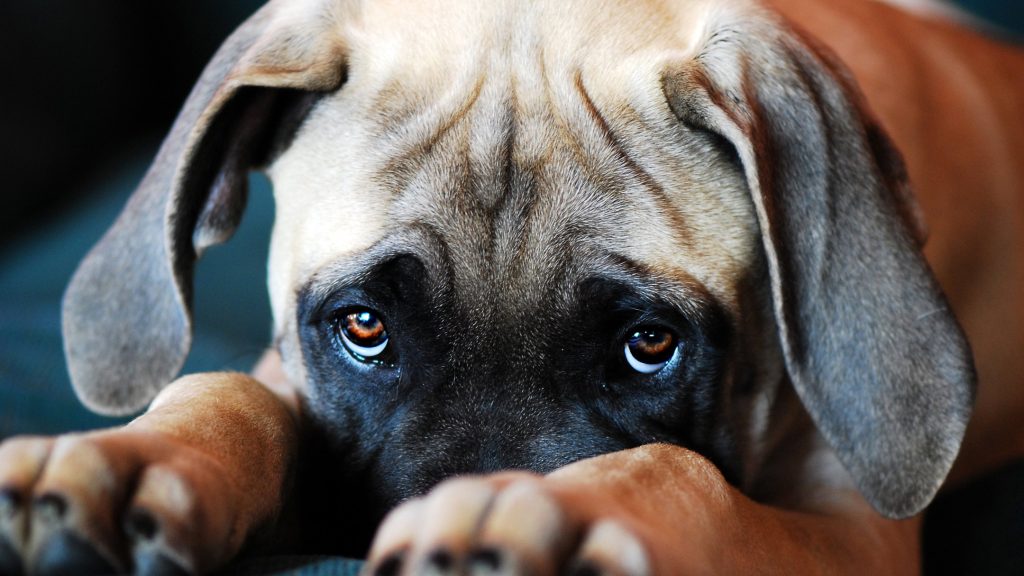
If we constantly furrow, as we get older our foreheads can develop deeper furrows that become permanent wrinkles. If you see deep furrows on a person’s forehead, it can signal a challenging life in which the person engages in frequent frowning. However, it could also mean someone has spent a lot of hours outdoors in the sun.
The Problem With Botox
Botox may mask true sentiments and obscure stress lines. A “botoxed forehead” can even cause problems for some couples and children who normally look to the forehead for information to see how the person feels12https://www.amazon.com/Dictionary-Body-Language-Field-Behavior/dp/0062846876. Babies as young as 4 weeks respond to the furrowed forehead as something negative, but with botox that signal is gone.
Both children and adults report the inability to read parents or spouses who used botox. It becomes harder for them to read emotional cues after botox versus before the botox treatment.
Leaning head on hand
What It Means: Take a look at any college classroom around the world, and you may see students leaning their head on their hand. Sometimes you can even see their cheek smushing out from the weight of their head leaning on their palm.
Leaning heads show they are disinterested or bored and prefer to use the least amount of energy possible—they can’t even be bothered to hold their head up.
There are 3 levels to this cue8https://www.amazon.com/Definitive-Book-Body-Language-attitudes/dp/1409168506
- Usually, it begins with the chin supported by the thumb.
- Then, as interest dwindles, the thumb will likely be replaced by the fist.
- And in the case of extreme lack of interest, you may see someone fully plop their head onto their hands.
It may not only indicate disinterest. You might see a friend lean their head if they’re feeling very relaxed and comfortable. In short, this cue is ultracasual.

Pro Tip: How to Tell if Someone is Acting and Really Isn’t Interested
Some people might even feign interest by resting their head on their closed hand, but with an index finger pointed upwards. If this gesture continues, it may make people who are on the receiving end of the conversation feel as if they aren’t being respected or paid attention to. You might also see someone begin to hold their chin tup by resting it on their thumb—in this case it gives off the vibe of being critical or negative8https://www.amazon.com/Definitive-Book-Body-Language-attitudes/dp/1409168506.
It’s getting hot in here
What It Means: When I was a kid, I loved wearing hats.
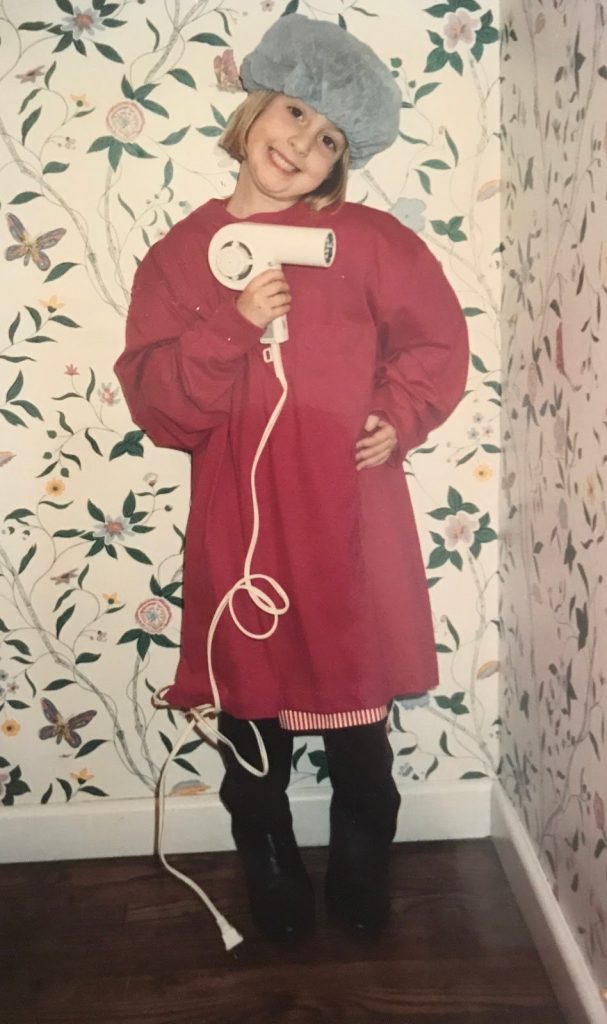
But I was also extremely shy and awkward, and under stressful situations, I would always have to take my hat off to avoid excessive sweat (sorry for the TMI!).
If a person takes off their hat, it could mean they feel hot or angry5https://www.amazon.com/Silent-Language-Leaders-Help-Hurt-How/dp/0470876360. Or, it might simply be the feeling of heat generated from stressful situations, like in my case.
I’ve only seen this once, in a bar during my college years, but I also observed someone taking their hat off before they threw a right fist straight into another guy’s noggin. Yikes!
Bonus: What Does Hair Indicate?
You can tell a lot, just by looking at the condition of someone’s hair. Anthropologist David Givens says the hair serves as an “unofficial resume”12https://www.amazon.com/Dictionary-Body-Language-Field-Behavior/dp/0062846876. Hair can reveal:
- one’s rank in an organization (especially in the military)
- their attitude toward trends and society (fashionable/old school)
- what they believe in (styled similar to favorite bands, etc.)
- how they see themselves (clean/messy)
- willingness to defy convention (as in dyed hair)
- leadership status (as in head adornments like Native Americans’ chief feathers)
- occupation (such as wearing a farmer’s hat)
- social status (disheveled, clean and trimmed, etc.)
- allegiance (such as religion)
Have you ever prepared for a date or business meeting, and no matter how much hair product you used, your hair just didn’t work?
In many cultures—I would even say most—hair is critical to dating, romance, and looking professional.
Fun Fact: Why Did People Used To Wear Big Wigs?
It wasn’t just for show. We could even go back to the time of Louis XIV when he was at the age of 32. During his time, only the rich could afford the really large wigs made of several real heads of hair known as “bigwigs.” Since Louis was balding, each morning he started his day by putting on a magnificent black wig handed to him through closed bed-curtain. And he would hand it back again the same way at night so nobody would catch a glimpse of his shiny, bald head10https://www.amazon.com/Peoplewatching-Desmond-Morris-Guide-Language/dp/0099429780.
Even more recently, in Austin, Texas, in the year 1973, long hair on boys and men was a “sign of a sissy” and, according to Texas High School Coaches Association’s magazine, it should be banned. And, a couple years later in Connecticut, a woman was fired from waitressing because she refused to shave her legs!
Even the Cacobno Indians of the Amazon rainforest carefully trim and groom their head and hair… but eliminate their eyebrows completely by plucking them.
All hair styles depend on the culture and time period.
Now, how did you do? Did you learn a lot? People use their head ALL the time in body language. And it’s up to you to spot these subtle turns and nods to decipher peoples’ true emotions.
Now, check out what’s next in the body language line-up!
Crack The Code on Facial Expressions
The human face is constantly sending signals, and we use it to understand the person’s intentions when we speak to them.
In Decode, we dive deep into these microexpressions to teach you how to instantly pick up on them and understand the meaning behind what is said to you.
Don’t spend another day living in the dark.
Side Note: As much as possible we tried to use academic research or expert opinion for this master body language guide. Occasionally, when we could not find research we include anecdotes that are helpful. As more research comes out on nonverbal behavior we will be sure to add it!
This article is part of our body language guide. Click here for more.
Article sources
- https://journals.sagepub.com/doi/10.1177/002383098302600202
- https://www.amazon.com/The-Body-Language-Advantage-Relationships/dp/1592335152?tag=bisafetynet2-20
- https://www.amazon.com/Nonverbal-Communication-Human-Interaction-Knapp/dp/1133311598
- https://onlinelibrary.wiley.com/doi/abs/10.1111/eth.12412
- https://www.amazon.com/Silent-Language-Leaders-Help-Hurt-How/dp/0470876360
- https://psycnet.apa.org/doiLanding?doi=10.1037%2F0012-1649.21.3.473
- https://nicolasfradet.com/hand-shrugging-a-very-revealing-poker-tell/
- https://www.amazon.com/Definitive-Book-Body-Language-attitudes/dp/1409168506
- https://www.amazon.com/Dictionary-Body-Language-Field-Behavior-ebook/dp/B075JDX981
- https://www.amazon.com/Peoplewatching-Desmond-Morris-Guide-Language/dp/0099429780
- https://www.researchgate.net/publication/228504501_Facial_expressions_in_various_emotional_states_in_congenitally_blind_and_sighted_subjects
- https://www.amazon.com/Dictionary-Body-Language-Field-Behavior/dp/0062846876
How to Deal with Difficult People at Work
Do you have a difficult boss? Colleague? Client? Learn how to transform your difficult relationship.
I’ll show you my science-based approach to building a strong, productive relationship with even the most difficult people.
